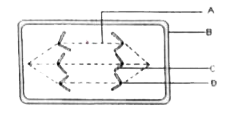Cell division usually involves
Karyokinesis followed by cytokinesis
Karyokinesis preceded by cytokinesis
Cytokinesis followed by karyokinesis
1 and 3
The correct Answer is:A
Step-by-Step Solution:
1. Understanding Cell Division: Cell division is the process by which a parent cell divides to form two daughter cells. This process is essential for growth, development, and repair in multicellular organisms.
2. Identifying the Two Main Processes: Cell division typically involves two main processes:
- Cytokinesis: This is the division of the cytoplasm, which occurs after the nucleus has divided.
- Karyokinesis: This is the division of the nucleus, which occurs before cytokinesis.
3. Sequence of Events: In a typical cell division:
- First, the nucleus divides (karyokinesis).
- Then, the cytoplasm divides (cytokinesis).
Therefore, the correct sequence is karyokinesis followed by cytokinesis.
4. Analyzing the Options: The options given in the question are:
- Option 1: Karyokinesis followed by cytokinesis
- Option 2: Karyokinesis preceded by cytokinesis
- Option 3: Cytokinesis followed by karyokinesis
- Option 4: Options 1 and 3
Based on our understanding, option 1 is correct because karyokinesis occurs first, followed by cytokinesis.
5. Conclusion: The correct answer to the question "Cell division usually involves" is option 1: Karyokinesis followed by cytokinesis.
---
- Cytokinesis: This is the division of the cytoplasm, which occurs after the nucleus has divided.
- Karyokinesis: This is the division of the nucleus, which occurs before cytokinesis.
- First, the nucleus divides (karyokinesis).
- Then, the cytoplasm divides (cytokinesis).
Therefore, the correct sequence is karyokinesis followed by cytokinesis.
- Option 1: Karyokinesis followed by cytokinesis
- Option 2: Karyokinesis preceded by cytokinesis
- Option 3: Cytokinesis followed by karyokinesis
- Option 4: Options 1 and 3
Topper's Solved these Questions
- CELL CYCLE AND CELL DIVISIONBOOK - AAKASH SERIESCHAPTER - CELL CYCLE AND CELL DIVISIONEXERCISE - Exercise-II
116 Videos
- CELL CYCLE AND CELL DIVISIONBOOK - AAKASH SERIESCHAPTER - CELL CYCLE AND CELL DIVISIONEXERCISE - Exercise-III
18 Videos
- BIOMOLECULESBOOK - AAKASH SERIESCHAPTER - BIOMOLECULESEXERCISE - EXERCISE - III (Previous AIPMT/NEET Questions) (Enzymes)
11 Videos
- ECOSYSTEMBOOK - AAKASH SERIESCHAPTER - ECOSYSTEMEXERCISE - EXERCISE-III (PREVIOUS AIPMT/NEET QUESTIONS)
37 Videos
Similar Questions
The diagram given below represents a stage in cell division. Study the same and answer the questions that follows:

Where does this type of cell division usually occur?
View SolutionReductional division involves
View SolutionCell division -mitosis
View SolutionThe cell division involved' in gamete formation is not of the same type in different organisms. Justify.
View SolutionHow many chromosomes do drones of honeybee possess ? Name the type of cell division involved in the production of sperms by them.
View SolutionGive a brief account of the various reaction intermediates usually involved in organic reactions.
View SolutionCell division itself is a mode of reproduction in
View SolutionIn a longitudinal section of a root, starting from the tip upward, the four zones occur in the following order
(a) Cell division, cell enlargement, cell maturation, root cap
(b) Cell division cell matuation, cell enlargement, root cap
(c) Root cap, cell division, cell enlargement, cell maturation
(d) Root cap, cell division, cell maturation, cell enlargement
View SolutionCell division is initiated by
View SolutionWhich type of cell division is called somatic cell division ?
View Solution
